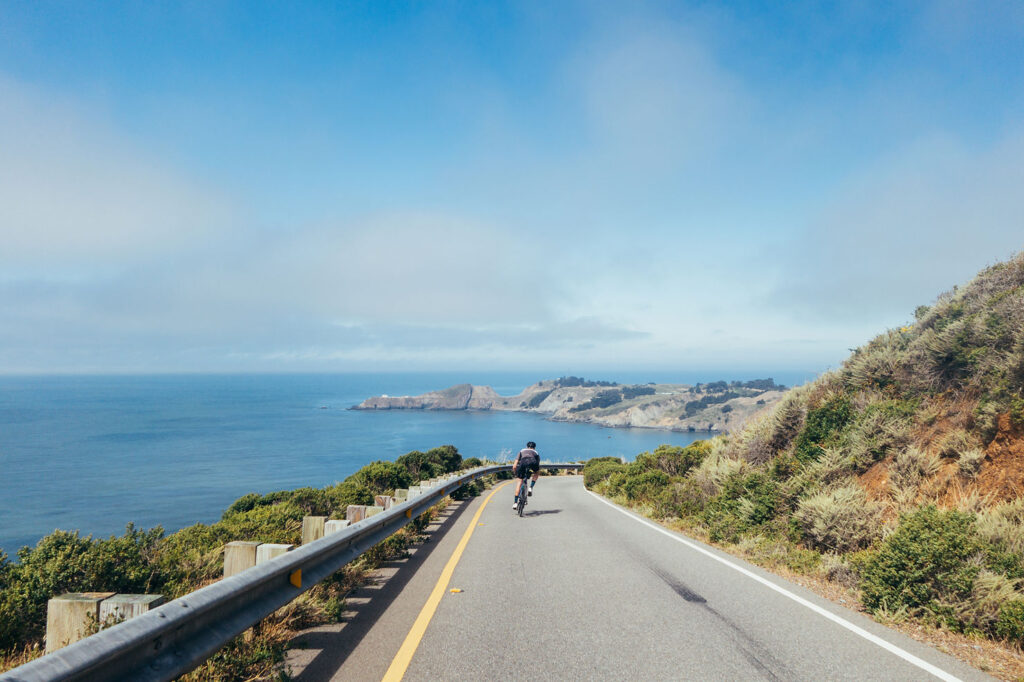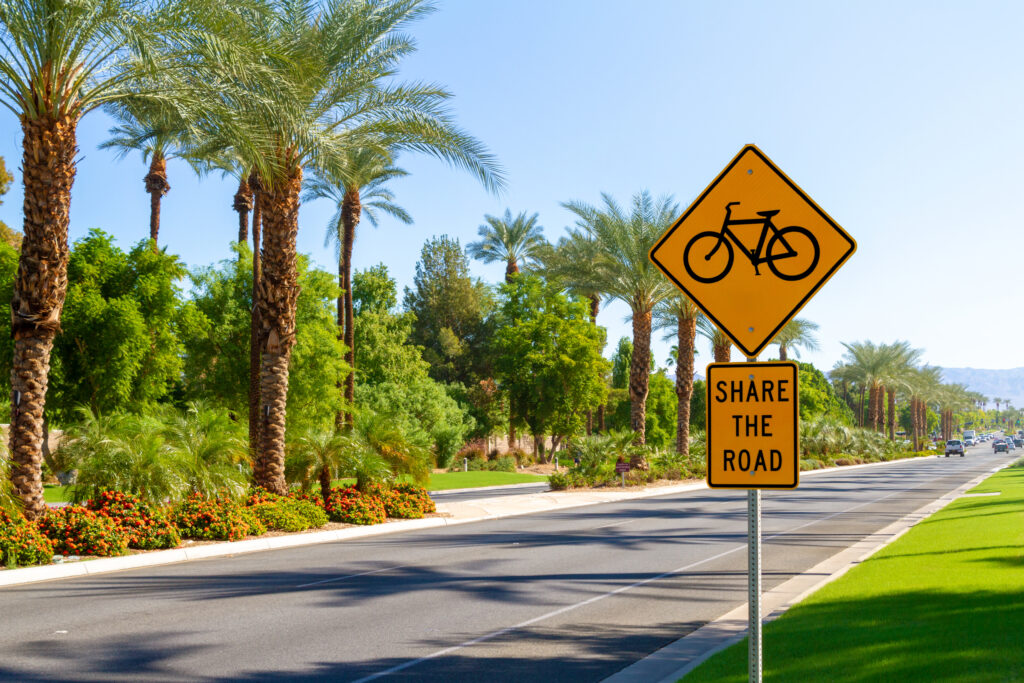The Golden Rules of the Road

Whether it’s your first ride or you’ve been riding for years, every cyclist wants a safer and enjoyable experience. That’s why it’s so important to master the bicycle laws of the golden state…before you hit the road. In doing so, you’ll help ensure a safer experience for yourself and those around you, while fostering a positive image of cyclists in your community. And what can be more golden than that? The Right Side: Riding on the right side of the road is not only a legal requirement of California, but also a crucial aspect of group ride safety and efficiency. Cyclists must ride on the right side of the road, in line with the traffic flow, with the exception of making a legal left turn, passing other cyclists, riding on a one-way street, when going down a road too narrow to share, or when the right side of the road is blocked off for construction. The Right Equipment: In California, certain equipment requirements must be met for a safer and legal cycling experience. Cyclists are required to have a white front light and a red rear reflector or light for nighttime use. Additionally, helmets that comply with the American National Standards Institute (ANSI) or the Snell Memorial Foundation standards must be worn by riders under the age of 18. Know the Signs: Obeying traffic signals and signs is essential for cyclists in California, as it guarantees the safety of all road users and helps prevent accidents. Cyclists must comply with all traffic signals and signs, including stop signs, yield signs, and traffic lights, just like any other vehicle on the road. During group rides, it’s particularly important to accommodate slower riders and maintain a safer and inclusive environment for everyone involved. Failing to adhere to traffic signals and signs can result in fines or other penalties, as well as create dangerous situations for both cyclists and motorists. Sidewalk Dos and Don’ts: While there is no state-level prohibition against sidewalk cycling in California, it’s essential to check local ordinances in your area for any additional regulations. Cycling on sidewalks can pose risks due to the presence of pedestrians, cars, and other cyclists, so it’s important to be mindful of your surroundings and adhere to the rules of the road when doing so. Common Violations and Penalties: Some of the most common bicycle-related violations in California include riding against the flow of traffic, navigating on the incorrect side of the road, failure to yield, disregarding red lights or stop signs, riding while under the influence, not using lights during night hours, and not wearing a helmet when required. Penalties for these violations can range from a warning to a fine of up to $250. By adhering to traffic laws and practicing safer cycling habits, you can avoid these violations and enjoy a trouble-free ride. Don’t be afraid to ask: Experienced riders can provide valuable insights and advice on local cycling regulations, so don’t hesitate to ask for guidance from your fellow cyclists or local bike shop. By following the golden rules and sharing the road responsibly with motorists, you’ll set yourself up for success and foster a positive cycling community.
Top Risks and Most Common Dangers of Cycling on the Road

Cycling on the road presents many dangers such as potholes, traffic interactions, and low visibility. To ride safely, it’s crucial to understand the most common dangers of cycling on the road and how to navigate them. This guide will help you identify these hazards and provide practical tips for safer cycling. Key Takeaways Common Road Hazards for Cyclists Cyclists face numerous risks from road hazards, which can stem from both environmental factors and human negligence. From potholes to road debris, and poorly maintained bike lanes, these hazards can cause significant injuries or damage to bicycles. Being aware of these dangers and knowing how to navigate them effectively ensures safer rides. Every cyclist should understand the specific types of hazards, such as potholes, debris, and inadequately maintained bike lanes. Each of these hazards requires different skills and awareness levels to avoid accidents. Let’s explore these common road hazards in more detail. Potholes and Uneven Surfaces Potholes can be particularly hazardous for cyclists, often leading to loss of control or severe injuries if not navigated carefully. Hitting a pothole unexpectedly can throw a cyclist off their bike, resulting in serious accidents. Cyclists should develop the skill to navigate around potholes to maintain bicycle safety. This includes staying alert and scanning the road ahead to avoid these dangerous obstacles. Debris on the Road Road debris, including loose materials like gravel and broken glass, poses critical hazards for cyclists and gravel bikes. These can puncture tires, leading to potentially dangerous falls and crashes. Remaining vigilant to notice and avoid such debris is crucial, as neglecting it can result in serious accidents and injuries. Poorly Maintained Bike Lanes Poorly maintained bike lanes can significantly increase the risk of accidents for cyclists. Issues like potholes, debris, and unclear road markings within bike lanes create unsafe conditions that can lead to falls and collisions. These lanes must be adequately maintained to ensure the safety of all cyclists on the road and the bike lane. Interactions with Motor Vehicles The greatest safety risk for cyclists is interactions with motor vehicles. Accidents involving vehicles are often underreported, so cyclists need to be extra cautious. Intersections, in particular, pose substantial risks, especially from turning vehicles that may not always see cyclists. Bicyclists are required to follow the same traffic laws as motorists, including obeying signals and road signs to ensure safety on the road. Cyclists can navigate traffic more safely by understanding the dangers posed by vehicle blind spots, dooring incidents, and close passes. Each of these scenarios requires specific awareness and strategies to avoid accidents. Let’s delve into these common interactions and how to manage them effectively. Vehicle Blind Spots Large vehicles, such as trucks and buses, have extensive blind spots that can put cyclists at significant risk. These blind spots can obscure cyclists from drivers’ views, making collisions more likely. Awareness of these areas and avoiding them whenever possible helps cyclists stay safer. Dooring Incidents Dooring incidents occur when a motorist opens a car door into a cyclist’s path, posing a severe danger. Such incidents often result in severe injuries as cyclists collide with the suddenly opened door. Drivers should check their mirrors before opening doors to prevent these accidents, and cyclists should ride at a safer distance from parked cars. Close Passes Vehicles passing too closely to cyclists pose a significant threat to their safety. Insufficient space when vehicles overtake cyclists can lead to dangerous situations and increase the likelihood of collisions. Motorists should give cyclists ample space when passing to ensure their safety on the road. Navigating Intersections Intersections are high-risk areas for cyclists, with a significant number of collisions occurring in these zones. Right-hook and left-hook collisions are particularly prevalent, happening when vehicles turn across the path of cyclists. Familiarity with traffic signs and signals helps cyclists navigate intersections safely and reduce their risk of accidents. To minimize the risk of collisions at intersections, cyclists should continuously scan for traffic and signal their intentions clearly. Understanding the types of collisions and how to avoid them significantly enhances cyclist safety at these critical points. Right-Hook and Left-Hook Collisions Right-hook collisions occur when a vehicle turns right across the path of an oncoming cyclist, often leading to serious injuries. These collisions typically happen when a vehicle passes a cyclist and then turns right, misjudging the cyclist’s speed or location. Left-hook collisions, on the other hand, occur when a vehicle turns left into the path of a cyclist, often leading to severe accidents. Being vigilant at intersections and signaling intentions helps cyclists avoid dangerous situations. Misunderstood Traffic Signs and Signals Cyclists must understand traffic signals to navigate intersections safely and avoid accidents. Failure to recognize or misinterpret traffic signs can lead to dangerous situations. Cyclists must follow traffic signals closely to ensure their safety and prevent collisions with vehicles. Night Riding and Low Visibility Cycling at night significantly increases the risk of accidents due to lower visibility conditions. Reduced visibility for both cyclists and motorists can lead to dangerous situations. Adopting safer behaviors and practices enhances cyclists’ visibility and predictability on the road. Using a road bike for night riding can be effective, but it is crucial to ensure proper visibility. To improve safety during night rides, cyclists should wear bright clothing and use lights to make themselves more visible to drivers. Additionally, adverse weather conditions like rain and fog can further impair visibility, making it essential for cyclists to adjust their riding techniques accordingly. Importance of Bright Clothing and Lights Bright colors and reflective gear enhance visibility to motorists when riding at night. Front and rear lights on a bicycle ensure that cyclists are seen by others on the road. Reflective gear and bright clothing significantly enhance a cyclist’s visibility, helping to prevent accidents in low-light conditions. Weather Conditions Adverse weather conditions like rain and fog can severely impair visibility, heightening the dangers for cyclists. Cyclists should adjust their riding strategies in such conditions to maintain safety. This includes slowing down, using lights, and wearing appropriate
Lawyers 4 Cyclists Founder, Steve Rosen, Featured on CBS News Report on E-Bike Safety

2 On Your Side: Orange County Sees Spike In E-Bike Accidents Founder of Lawyers for Cyclists was recently interviewed on CBS2 as an authority on e-bike injuries and safety. “…The amount of growth we’ve seen in accidents, and specifically catastrophic injuries related to e-bikes, is steadily on the rise,” said Steve Rosen. Rosen says many of his clients treated e-bikes as they would traditional bicycles. “I think people mistakenly believe that e-bikes are just like any bicycle,” Rosen said. “‘I am just getting on a bike. I am going to ride it like I have since I was 4-years-old.’ It’s not. It’s more akin to a motorcycle or mopeds we used to have.” For full story, go here.


